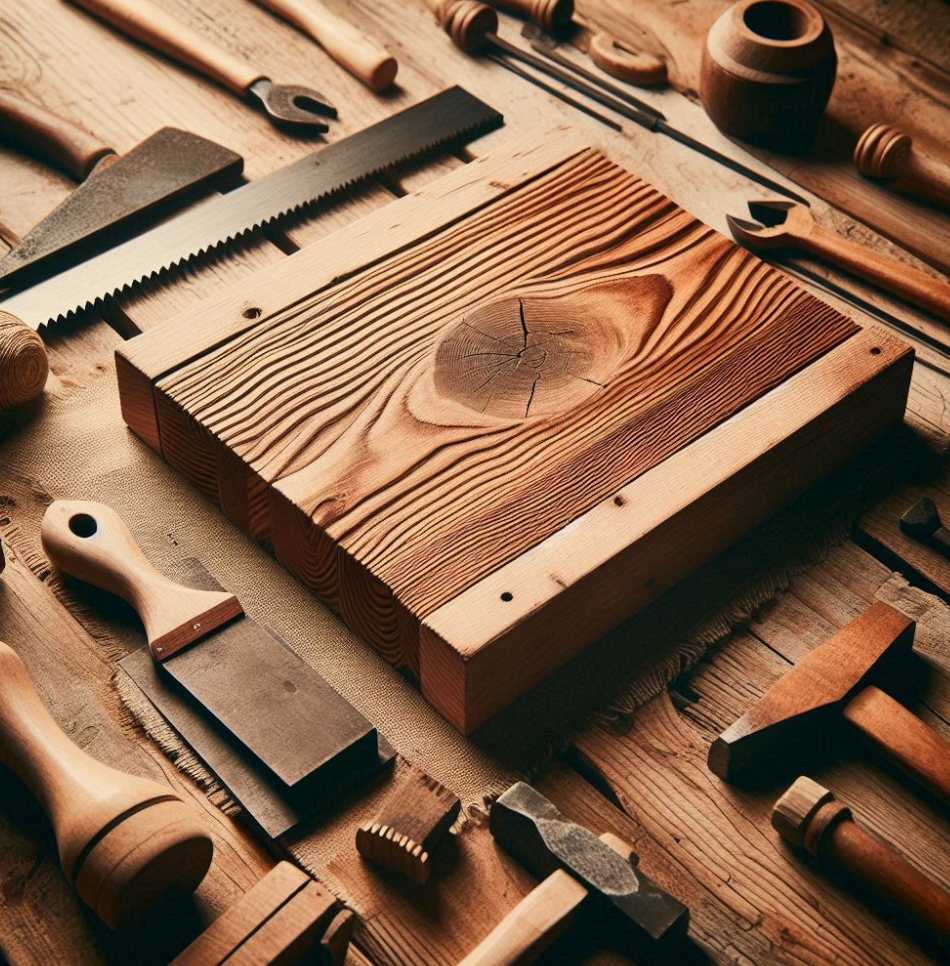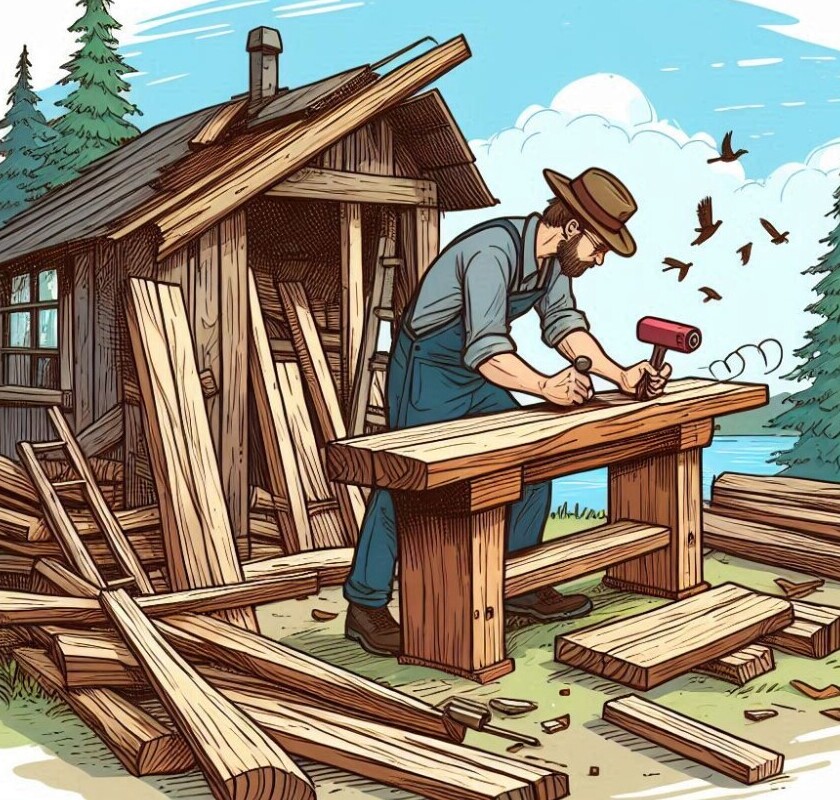 Embracing imperfection is more than just a trendy idea—it’s a way of seeing the world, especially in the realm of DIY woodworking. Now, some folks might say that woodworking’s all about precision, but there’s a whole different side to it.
Embracing imperfection is more than just a trendy idea—it’s a way of seeing the world, especially in the realm of DIY woodworking. Now, some folks might say that woodworking’s all about precision, but there’s a whole different side to it.
This approach is heavily inspired by the Japanese philosophy of Wabi-Sabi. It’s about finding beauty in the imperfect, accepting things as they are, and finding richness in the work that doesn’t scream ‘manufactured.’ In DIY woodworking, this perspective allows you to appreciate the quirks in your projects as part of their story.
Incorporating imperfections into your woodworking is surprisingly liberating. When you step away from the illusion of ‘perfect,’ you’re opening the door to personal and creative growth. This isn’t just about making beautiful things—we’re talking about becoming more resilient in the face of challenges.
Here’s why this matters: when you accept the flaws in your projects, you start seeing them as opportunities to learn and grow. It builds a kind of personal resilience you carry into other areas of life. Plus, there’s a kind of pride in seeing the beauty in what doesn’t adhere to the cookie-cutter standards.
The Beauty of Natural Wood Flaws
Let’s dive into the artistry of natural wood. Each piece of wood sings its own song with knots, grains, and textures that scream nature. That’s the real charm. No two pieces are exactly the same, and that’s where the magic lies.
When you embrace these natural quirks, you’re setting your projects apart from the mass-produced, uniform stuff out there. There’s a soul and character in those knots and grains that a machine-made replica just can’t match.
Using these natural features as the centerpiece of your design? That’s a pro move. Highlight that unique grain or make a feature of a gorgeous knot. It turns what some might see as a flaw into a focal point.
Nature’s patterns tell a story, and when you let those patterns shine, you’re adding depth and interest to every project. That’s something special when you’re working with your hands. It makes the process just as rewarding as the finished product.
Next time you’re picking out wood for your project, look for those imperfections. Think of them not as hurdles but as opportunities. They’re nature’s way of giving your work a personal touch.
Learning from Mistakes: A Step Towards Mastery
In the world of DIY woodworking, mistakes happen more often than not. Maybe a cut doesn’t line up perfectly, or a joint isn’t quite right. Instead of seeing these as failures, consider them as some of the greatest opportunities for learning you’ll ever have.
Every mishap is a chance to develop your skills. It’s not just about fixing what went wrong, but understanding why it happened in the first place. That’s how you start to master your craft.
Facing these challenges head-on builds more than just skill. You find patience and resilience you didn’t know you had. You learn to pause, assess, and adapt, which is crucial when working with something as dynamic as wood.
Mistakes also encourage creative problem solving. Maybe that mistaken cut can turn into a new design feature, or a botched joint means you try a new technique. These little twists can lead to results that surprise you in the best way.
Don’t be afraid to experiment and test your limits. The more you try, the more you learn, and every project you work on becomes a testament to how far you’ve come. Remember, no craftsperson ever reached mastery without a few blunders along the way.
Tools of the Trade: Navigating Imperfections Effectively
When dealing with wood’s quirky imperfections, the right tools can make all the difference. It’s not about fighting against those little quirks, but working with them to bring out your project’s best.
Think about tools that help you accentuate rather than hide those natural flaws. For example, a well-handled chisel can add character-enhancing carvings around a grain pattern, turning what might seem like a flaw into an artistic statement.
Sometimes, a little repair is needed, and knowing how to handle those small fixes without compromising your project is crucial. Techniques for filling, sanding, or even embracing a crack with some creative detailing can keep the integrity of your work intact.
Choosing the right materials can also make or break your project. If you anticipate certain imperfections in your chosen wood, be smart about balancing aesthetics and structure. Some woods might not hold up under pressure, so knowing what you’re working with will save headaches later.
Learning techniques with specialized tools to enhance the wood’s natural qualities can elevate your skills. It’s about having the knowledge to choose and use the right tool for each unique situation. This understanding bridges the gap between seeing imperfections as roadblocks and using them for creative expression.
Designing Openly: Building Creativity Through Limitations
In woodworking, embracing limitations isn’t limiting your creativity—it’s actually opening the gates to endless design possibilities. When flaws are part of your approach, you start looking at your projects differently, often with more imagination.
Each challenge becomes a catalyst for innovation. Say you’ve got a piece with an awkward blemish. Instead of covering it, think about how that imperfection can enhance the design. Maybe it can be the center of a spiral carving or a spot for an inset of contrasting material. The unexpected turns into an artistic feature.
Take inspiration from projects where little flaws became defining elements. Designing around imperfections can push you to explore new techniques and solutions you might not consider otherwise. It’s exactly these ‘undesirable’ elements that often lead to some of the most beloved work.
Flexibility in design not only bolsters creativity but also builds confidence. You’re continuously learning to adapt and see things in a new way, which only enriches your overall design skill. Open yourself up to exploring what these quirks can offer beyond aesthetics—think about the story and unique signature they bring to your creations.
This concept isn’t about making do with what you have; it’s about seeing potential where others might not. It’s a mindset that can transform not just wood, but the way you tackle challenges in any creative endeavor.
Sustainability and Natural Aesthetics
The world’s shifting towards more eco-friendly methods, and woodworking isn’t staying behind. Woodworking that respects and highlights nature’s own blemishes not only celebrates the uniqueness of each project but also aligns with sustainable practices.
Using reclaimed wood is one way to embrace imperfection sustainably. Each piece of timber has a history, with marks and scars that speak of its previous life—what’s more eco-friendly than giving it a new life? This isn’t just conservation; it’s transformation.
This approach embraces what’s already there rather than wiping it clean like a fresh slate. By using the character of recycled wood, you’re reducing demand for new resources and creating something beautiful and unique. You’re making conscious choices that reflect an appreciation for what nature originally crafted.
There’s a growing trend towards sustainability, and it’s impacting everything from techniques to materials. The more you work with nature instead of against it, the more you learn to respect the boundaries it sets. By choosing naturally flawed or reclaimed materials, you’re not only making a statement about sustainability but also ensuring that your work holds a distinct character that’s impossible to replicate.
Choosing materials and techniques that honor these principles doesn’t only benefit the environment; it also teaches us about valuing the process just as much as the end result. That’s the beauty of woodworking with purpose.
This isn’t just a trend—it’s a new way of thinking that adds depth to your projects and reflects a commitment to environmental responsibility. Plus, it’s just downright cool to be able to say that your one-of-a-kind piece reduces waste and celebrates nature.
Personal Story: Growing Through My Own DIY Journey
I’ve had my fair share of bumps and bruises on my DIY woodworking journey. Every project comes with its own set of challenges, and they’re not always the ones you expect. From misaligned pieces to unexpected cracks, there’s no shortage of surprises.
One of my first major projects was supposed to be a simple coffee table. Halfway through, a miscut led to a surface that wasn’t exactly level, but instead of scrapping it, I decided to embrace it. I went with a staggered pattern using different boards, turning what could have been a disaster into a unique design that everyone admired.
Sharing these projects, imperfections and all, has taught me a great deal. There’s a delicate dance between pride in what you’ve made and humility in accepting its shortcomings. Each imperfection adds a narrative that connects the maker, the process, and the piece itself.
Encouragement grows when you’re open about your missteps. Beginners often feel like they have to be perfect right out of the gate, but when they see that even experienced hands make mistakes, it inspires resilience. It’s a reminder that every builder starts somewhere and that the scratches and dents along the way are just part of the learning process.
Reflecting on these experiences is incredibly rewarding. It’s in these moments of vulnerability and growth that I’ve come to appreciate the imperfections not just in the projects, but as part of my own learning and evolving craftsmanship.
The Impact on Overall Well-being
Woodworking isn’t just about creating; it’s about the journey, and embracing imperfections plays a huge role in personal satisfaction. Picking up a tool and working with your hands taps into something primal and profoundly satisfying.
Mindfulness comes into play when you’re focused on your project, especially dealing with its flaws up close. Each careful stroke, every small adjustment requires presence and patience—an almost meditative practice that helps center your thoughts in today’s buzzed world.
Craftsmanship offers a sense of accomplishment that’s hard to find elsewhere. When you embrace the imperfections, you open yourself up to accepting life’s unpredictability with a greater sense of calm and adaptability. It’s incredible how these hands-on exercises can cultivate self-awareness and peace.
Community feedback also plays a big part here. Exchanging ideas, tips, and even stories behind those ‘oops’ moments can foster a sense of belonging. Sharing your journey with others—whether through workshops, forums, or casual chats—not only brings about new insights but provides assurance that you’re not alone in the struggle.
The therapeutic aspect of woodworking often goes unspoken, but it’s there every step of the way. Working with wood, especially when celebrating its natural flaws, nurtures not just creativity, but mental and emotional well-being too. It’s a reminder that creating from the heart is one of life’s simple and genuine pleasures.
Conclusion: The Imperfect Path to Perfect Satisfaction
Embracing imperfection in woodworking is more than a creative choice—it’s a fulfilling journey that enriches both the maker and the crafted piece. This path transforms how we approach challenges, turning them into opportunities for genuine expression.
By accepting the natural quirks and learning from every hiccup along the way, we unlock personal and professional growth. This isn’t just about woodworking anymore; it becomes a reflection of how we tackle life’s imperfections.
Every knot, grain, and unexpected mark is a testament to a unique story, revealing craftsmanship that celebrates individuality in a world full of repetition.
Sharing these experiences with fellow enthusiasts connects us on a level that extends beyond the workshop, linking us through stories that inspire and motivate.
This acceptance also brings a greater sense of satisfaction, knowing that each creation is a heartfelt representation of resilience and creativity.
As you continue your woodworking adventures, hold onto this mindset. Embrace the flaws, and let them guide you to new heights of craft and character. The satisfaction you draw from this process will be as distinctive as the pieces you create.

About The Author
Neal
Neal is a proud retired firefighter and paramedic, having dedicated 33 years to serving his community with unwavering courage and commitment. Beyond his professional achievements, Neal is a devoted family man, married to his wonderful wife of 20 years. Together, they are blessed with a married daughter and two incredible grandsons who bring endless joy into his life.
In recent years, Neal has embraced his late father’s passion for woodworking, carrying forward a beloved legacy. His father, affectionately known around town as “The Turkey Man,” was renowned for crafting exceptional wild game calls, specializing in turkey calls but also creating those for deer, goose, duck, owl, injured animals, and coyotes. Inspired by this heritage, Neal ventured into woodworking himself, creating charming craft items and beautiful furniture. For Neal, this hobby is not only a creative outlet but also a heartfelt connection to his father’s memory.
